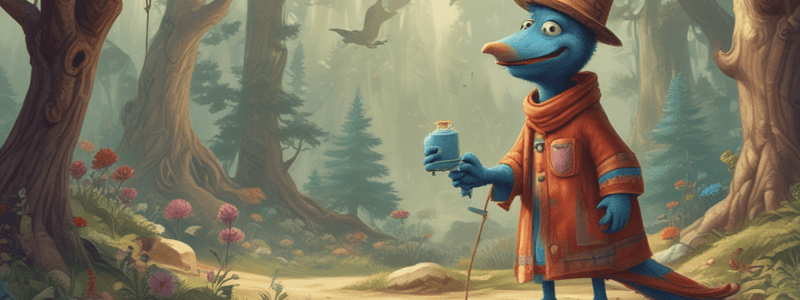Podcast
Questions and Answers
What is Grover's primary concern throughout the story?
What is Grover's primary concern throughout the story?
- Encountering a friendly monster
- Face-to-face confrontation with the monster
- Finding out the identity of the monster
- The possibility of being the monster himself (correct)
How does Grover attempt to prevent the reader from turning the pages?
How does Grover attempt to prevent the reader from turning the pages?
- By physically nailing the pages together (correct)
- By creating a distraction with a joke
- By changing the story's direction entirely
- By offering a reward for not turning the pages
What is one of the main themes of 'The Monster at the End of This Book'?
What is one of the main themes of 'The Monster at the End of This Book'?
- The value of anticipating outcomes in a story
- The importance of sharing fears with friends
- The irrationality of fear and the bravery it takes to confront it (correct)
- The role of humor in children's literature
What type of tone does Grover use when addressing the reader?
What type of tone does Grover use when addressing the reader?
What illustration technique is used in the book to depict Grover?
What illustration technique is used in the book to depict Grover?
What is the outcome when the readers reach the end of the book?
What is the outcome when the readers reach the end of the book?
Which emotional responses does Grover display in the book?
Which emotional responses does Grover display in the book?
In what way is the book interactive for young readers?
In what way is the book interactive for young readers?
What is the overall message conveyed in the book when Grover faces his fear?
What is the overall message conveyed in the book when Grover faces his fear?
Flashcards are hidden until you start studying
Study Notes
Overview
- "The Monster at the End of This Book" is a children's book by Jon Stone, illustrated by Michael Smollin.
- The main character, Grover, is a lovable furry monster who fears a monster at the end of the book.
Plot Elements
- Grover expresses fear about encountering a monster at the end, prompting him to plead with the reader not to turn the pages.
- He employs various tactics to prevent page turning, including physically nailing pages together and using a solid brick.
- The narrative is character-driven, highlighting Grover's comedic attempts to avoid revealing the monster's identity.
Themes
- The story explores themes of fear and bravery, demonstrating how anticipation can heighten anxiety.
- Grover's antics illustrate how fear can be irrational, eventually revealing that he, himself, is the monster.
Characterization
- Grover is depicted as both humorous and endearing, creating a connection with young readers.
- His emotional responses provide insight into the human experiences of fear and embarrassment.
Interactive Engagement
- The book invites readers to participate by turning the pages, making it an interactive reading experience.
- Grover's direct address to the reader creates a conversational tone, enhancing engagement.
Conclusion
- The twist reveals that the feared monster is Grover, providing a light-hearted resolution that often evokes laughter.
- The story underscores that facing fears can sometimes lead to surprising self-discovery and humor.
Overview
- "The Monster at the End of This Book" is authored by Jon Stone and illustrated by Michael Smollin.
- Grover, the main character, is a furry monster notable for his comedic and relatable qualities.
Plot Elements
- Grover's fear of the monster at the end prompts him to engage the reader, pleading not to turn the pages.
- He uses humorous methods to prevent page turning, such as nailing pages together and placing a solid brick to block further reading.
- The story's character-driven narrative emphasizes Grover's amusing strategies to avoid confrontation with the presumed monster.
Themes
- The book addresses themes of fear versus bravery, demonstrating how anticipation can intensify anxiety and apprehension.
- Grover's journey reveals the irrational nature of fear, ultimately leading to the realization that he embodies the monster he fears.
Characterization
- Grover is characterized as humorous and endearing, which helps establish a connection with young readers.
- His emotional reactions provide a reflection of universal experiences related to fear and embarrassment, making him relatable to children.
Interactive Engagement
- The narrative encourages reader participation through active page turning, fostering an interactive and immersive reading experience.
- Grover's direct communication with readers creates a friendly, conversational atmosphere that enhances engagement with the story.
Conclusion
- The story concludes with the revelation that Grover himself is the monster, delivering a light-hearted twist that often brings laughter.
- This twist illustrates the idea that confronting one's fears can lead to unexpected self-discovery and even humor.
Studying That Suits You
Use AI to generate personalized quizzes and flashcards to suit your learning preferences.




